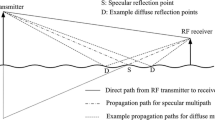Abstract
In the present paper multipath fading affecting the performance of an oversea digital microwave link situated in Western India is investigated. The results show that the highest number of severely error seconds are observed in the early morning and late evening hours. The investigations reveal that ground based layers are responsible for the high bit error rate observed and, elevated layers have no effect. The observed probability of outage is compared with that deduced from Serizawa’s and Lavergnat’s prediction methods.
Résumé
Les auteurs étudient les évanouissements par trajets multiples et leur effet sur les caractéristiques d’une liaison hertzienne au-dessus de la mer. Les résultats montrent que le plus grand nombre de secondes gravement erronées sont observées tôt le matin et tard le soir. Ces études montrent que les couches voisines de la surface sont responsables du taux élevé d’erreurs sur les bits tandis que les couches plus hautes sont sans effet. Les probabilités d’interruption observées sont comparées à celles obtenues en utilisant les méthodes de prévision de Serizawa et de Lavergnat.
Similar content being viewed by others
References
Di Zenobio (D.), Raji (T.). Automated power spectrum measurement for radio link characterisation.SBMO International Symposium Proceedings (1987), pp. 1183–1187.
Lin (S. H.). Measured relative performance of antenna pattern diversity, antenna angle diversity and vertical space diversity in Mississipi.IEEE Global Telecommunications Conf. (1988), pp. 1433–1439.
Ariyavisitakul (S.), Yoshida (S.), Ikegami (F.), Takeuchi (T.). A novel anti-multipath modulation technique dsk.IEEE Trans. Commun. (1987),35, no; 12, pp. 1252–1264.
Niemeyer (M.), Schwarz (W. S.), Sommer (B.). A new method to minimise the multipath effects of digital microwave LOS systems based on wideband measurements at 5 and 15 GHz.Proc 13th European Microwave Conf. (1983), pp. 675–680.
Barnett (W. T.). Multipath fading effects on digital radio.IEEE Trans. Commun. (1979),27, no 12, pp. 1842–1848.
Sasaki (O.), Akiyama (T.). Multipath delay characteristics on line-of-sight microwave radio systems.IEEE Trans. Commun. (1979),27, no 12, pp. 1876–1886.
Olsen (R. L.). The role of atmospheric stratification and surface effects in multipath propagation over terrestrial line-of-sight links : A review of some recent results.SBMO International Microwave Symposium (1989), pp.401–408.
Singal (S. P.), Aggarwal (S. K.), Pahwa (D. R.), Adiga (B. B.). Studies of marine boundary layer at Tarapur.Boundary Layer Meteorology (1986), pp. 371–383.
Craig (K. H.), Kennedy (G. R.). Studies of multipath propagation on a microwave line-of-sight link.Proc. 17th European Microwave Conf. (1987), pp. 523–528.
Beard (C. I.). Coherent and incoherent scattering of microwaves from the ocean.IRE Trans. Antennas and Propagation (1961),2, pp. 470–483.
Sakagami (S.), Hosoya (S.). Some experimental results on inband amplitude dispersion and a method for estimating inband linear amplitude dispersion.IEEE Trans. Commun. (1982),30, no 8, pp. 1875–1887.
Anderson (C. W.), Barber (S. G.), Patel (R. N.). The effect of selective fading on digital radio.IEEE Trans. Commun. (1979),27, no 12, pp. 1870–1876.
Serizawa (Y), Takeshita (S.). A simplified method for prediction of multipath fading outage of digital radio.IEEE Trans. Commun. (1983),31, no 8, pp. 1017–1021.
Barnett (W. T.). Multipath propagation at 4, 6, 11 GHz.Bell System Tech. Journal (1972),51, pp. 321–361.
Lavergnat (J.), Sylvain (M.), Bic (J. C). A method to predict multipath effects on a line-of-sight link.IEEE Trans. Commun. (1990),38, no 10, pp. 1810–1822.
Dougherty (H. T.), Hartman (W. J.). Performance of a 400 Mbit/s system over a line-of-sight path.IEEE Trans. Commun. (1977),25, no 4, pp. 427–432.
Netto (A. C. P.), Dhein (N. R.). Reduction of fadings due to ducts in los links by path inclination.Proc. of ISAP (1985), pp. 1071–1074.
Prasad (M. V. S. N.), Sarkar (S. K.), Dutta (H. N.), Reddy (B. M.). Fading reduction in los microwave links due to path inclination.Electronics Letters (31st Jan. 1991),27, no 3, pp. 259–261.
Lam (W. I.), Webster (A. R.). Microwave propagation on two line-of sight oversea paths.IEEE Trans. AP (1985),33, no 5, pp. 510–516.
Lee (J.). Dispersive microwave fading and lower atmospheric structure: An observational study.Radio Sci. (1989),24, no 2, pp. 133–146.
Mon (J. P.), Mayrargue (S.). Sodar monitoring of the lower atmosphere and prediction of propagation anomalies on line of sight paths.Internat. Conf. on Commun. (1981), pp. 68.6.1–68.6.4.
Kerr (D. E.). Propagation of short radio waves.Boston Technical Publishers (1961), USA, pp. 371–373.
Author information
Authors and Affiliations
Rights and permissions
About this article
Cite this article
Prasad, M.V.S.N., Sarkar, S.K., Dutta, H.N. et al. Multipath fading characteristics of a digital microwave link in Western India. Ann. Télécommun. 47, 49–55 (1992). https://doi.org/10.1007/BF02998726
Received:
Accepted:
Issue Date:
DOI: https://doi.org/10.1007/BF02998726
Key words
- Radio relay link
- Line of sight propagation
- Ground effect
- Sea
- Error rate
- Multipath propagation
- Statistical study
- Fading




